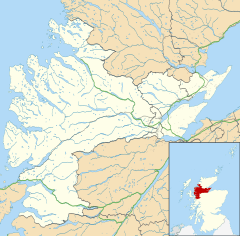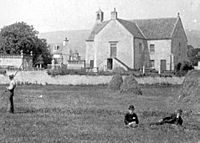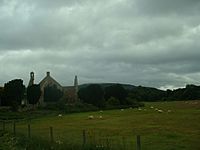Evanton facts for kids
Quick facts for kids Evanton
|
|
|---|---|
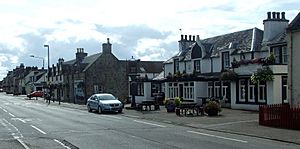 The main street from opposite the Novar Arms |
|
| Population | 1,390 (2020) |
| OS grid reference | NH 6068866089 |
| Council area | |
| Lieutenancy area | |
| Country | Scotland |
| Sovereign state | United Kingdom |
| Post town | DINGWALL |
| Postcode district | IV16 |
| Dialling code | 01349 |
| Police | Northern |
| Fire | Highlands and Islands |
| Ambulance | Scottish |
| EU Parliament | Scotland |
| UK Parliament |
|
| Scottish Parliament |
|
Evanton (Scottish Gaelic: Baile Eòghainn or Scottish Gaelic: Am Baile Ùr) is a small village in Easter Ross, Scotland. It is part of the Highland council area. Evanton is located between two rivers, the River Sgitheach and the Allt Graad. It is about 24 kilometers (15 miles) north of Inverness. The village is also near Alness and Dingwall.
Evanton has several streets, with Balconie Street being the main one. Many people who live here work in other parts of Easter Ross or the greater Inverness area. This is why it's called a "commuting settlement."
The village we see today was started in the early 1800s. Alexander Fraser of Inchcoulter/Balconie founded it. He named it after his son, Evan. Most of the village's older buildings are from the Victorian era. Evanton has fun places to visit, like the Fyrish monument and the Black Rock Gorge. There is also the old church of Kiltearn near the Cromarty Firth.
The village has two churches: one Church of Scotland and one Free Church of Scotland. There is one primary school. Older students go to high schools in Dingwall or Alness. The local forest is managed by the community.
Contents
- What is the history of Evanton?
- How is Evanton governed?
- What is the population of Evanton?
- What is the geography of Evanton?
- What is the economy like in Evanton?
- How do people travel in Evanton?
- What is the culture like in Evanton?
- What other interesting facts are there about Evanton?
- Images for kids
- See also
What is the history of Evanton?
How did Evanton get its start?
Evanton is located in an old area called Kiltearn. This area was once part of the "Earldom" of Ross. For a long time, the Munros of Foulis were powerful in this region. Their castle was only a few kilometers away.
The name Kiltearn comes from an old Gaelic word meaning "church." This tells us that a very old church was here before the year 800. Near Evanton, there was also an old farming settlement called Drummond.
In 1807, a local landowner named Alexander Fraser founded Evanton. He was clearing his lands for sheep farming. He created Evanton as a new home for the people who had to move. He named the village after his son, Evan.
Evanton was well-planned with a neat layout. In the 1840s, the Highlands faced a severe famine. In 1846, there was a riot in Evanton. People were upset because grain was still being sent away, even though the potato crop had failed. By the time of the First World War, Evanton looked much like it does today. It had many different businesses.
What happened in the 20th century?
In the 1900s, Evanton saw many changes. A whisky distillery closed in 1926. Balconie Castle, an important historical site, was taken down in 1965. It was too expensive to repair.
An RAF airfield was built near Evanton in 1922. It was first called the "Novar Base." Later, it was known as HMS Fieldfare. This airfield was used by planes from the Home Fleet base in Invergordon. The largest plane to land there was a USAAF B17. In 1939, the Evanton Aerodrome had 9,000 visitors on Empire Day. The base closed in the 1970s.
However, the oil boom in the 1970s helped Evanton grow a lot. The village has been getting bigger ever since.
How is Evanton governed?
Who represents Evanton in government?
Evanton is part of the Caithness, Sutherland and Easter Ross area for the UK Parliament. The current MP is Jamie Stone from the Liberal Democrats.
For the Scottish Parliament, people in Evanton vote for MSPs for the Caithness, Sutherland and Ross (Scottish Parliament constituency).
Evanton is also part of the Highland Council Area for local government. The village is in Kiltearn Parish, which has its own community council.
What is the population of Evanton?
Evanton's population is a bit younger than the rest of the Highland region. The number of people in Evanton depends on how it's counted. The "Evanton Settlement Zone" is larger than the "Evanton Settlement" itself.
The Evanton-zone has 671 homes and 1678 people. The Evanton-settlement alone has 1105 people. Both areas are growing. In the 1990s, the zone grew by 8.12%, and the settlement grew by 10.72%. Most houses in the zone are owned by the people living in them. About 16.4% of people in the Evanton-zone were born outside Scotland, mostly from England.
What is the geography of Evanton?
Evanton is surrounded by two rivers: the Allt Graad to the north-east and the River Sgitheach to the south-west. The Allt Graad, also called the River Glass, flows from Loch Glass. It passes the northern end of the village and goes into the Cromarty Firth.
Before reaching the Firth, the Allt Graad flows through the Black Rock Gorge. This gorge is very deep, reaching 36 meters (120 feet). In 2004, parts of the movie Harry Potter and the Goblet of Fire were filmed here. The gorge was used for the scene where Harry is chased by a dragon.
The River Sgitheach, also known as Skiack, is smaller. It flows from the mountains and passes several waterfalls. It then flows past the southern end of the village into the Cromarty Firth.
What is the economy like in Evanton?
Some people in Evanton work in the oil industry. This is because there are oil rigs nearby in the Cromarty Firth. Other important jobs in the area include forestry, tourism, and food services.
Many people work in larger towns nearby, like Inverness, Dingwall, Alness, and Invergordon. This is why most households in Evanton own a car. About 10.4% of people in the area are self-employed.
Evanton has two hotels and two bars. These businesses help bring in money from tourists.
Was there a distillery in Evanton?
Yes, there was a distillery in the Evanton area as early as the 1700s. The Glen Skiack distillery opened in 1896. It produced a small amount of whisky.
However, a law called Prohibition in the U.S. hurt all Scottish distilleries. Glen Skiack had to close in 1926. The building was torn down in 1933.
How do people travel in Evanton?
What is the history of the railway?
In 1860, the Highland Railway decided to build a railway line through Easter Ross. The line was finished by 1862. On May 23, 1863, Evanton got its own railway station. It was first called Novar, but was renamed "Evanton" in 1937.
Sadly, the station closed in June 1960. The old platforms are still there, but the signal posts are gone. The railway line, now called the "Far North Line," still passes by the village. You can hear the trains from far away. The closest train station today is Alness.
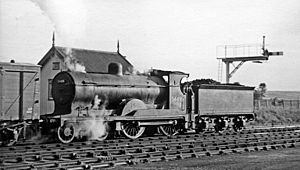
How has the A9 road changed Evanton?
The A9 connects Edinburgh with Inverness and the far north. This road used to go right through Evanton, along Balconie Street. However, a bypass was built to make the journey shorter.
This bypass reduced traffic in the village. But it also meant less money for local businesses. The road also cut through much of the local farmland. The village's gas station also closed.
For people without cars, the main way to travel is by walking or using the No. 25 bus service. Recently, an express bus service from Inverness to Dornoch started stopping in Evanton. This makes it easier for residents to work in Inverness without needing their own car.
What is the culture like in Evanton?
In the 1800s, people in Evanton spoke a mix of Gaelic and English. The local minister noted that children learned English easily after learning Gaelic. People wanted to learn English because it was spoken by the "higher classes."
Today, English is the main language. While you can see Gaelic written on the church walls, the language is not commonly spoken. However, about 72 residents (4.3%) still know Gaelic.
Evanton is also known for its lively music scene, especially traditional Gaelic music. Local musicians often meet in the village's pubs for evening music sessions. Famous Celtic musicians like Eilidh Steel and Dougie MacLean have visited.
What other interesting facts are there about Evanton?
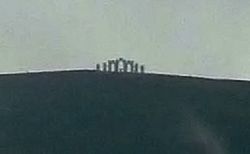
Evanton is home to the main office of Blythswood Care. This is an international charity.
In 2006, Evanton was the first place to host a tour of the new Scottish National Theatre. They chose to perform their play "Home" at a studio in the Evanton Industrial Estate.
Evanton has several public places. The Diamond Jubilee Hall opened in 1898. It was built with money from Major Randle Jackson and the local community. The hall is now managed by the community.
The Evanton Sports Centre is another public facility. It offers sports like badminton, basketball, football, and tennis. Evanton also has a large park at Teandallon. In recent years, a local group helped add a multisport area, a BMX track, and a half-pipe ramp. A new playpark for toddlers was added in 2007. The original park was also upgraded in 2008.
Images for kids
See also
 In Spanish: Evanton para niños
In Spanish: Evanton para niños


